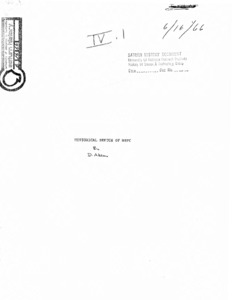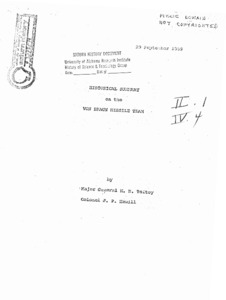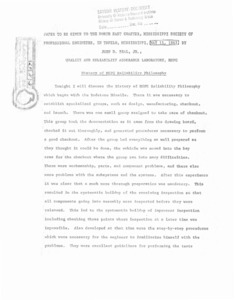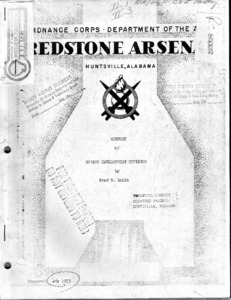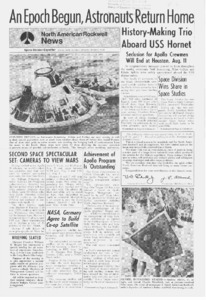
Browse Items (1976 total)
Sort by:
-
"Historical Notes on Oral History in NASA."
Prepared for the Second National Colloquium on Oral History, Columbia University. Contains notes on the oral history of NASA. -
"Historical Profile: North American Aviation, Inc."
Paper written as a study of functional management in NASA. -
"Historical Sketch of MSFC."
A rocket from the George C. Marshall Space Flight Center will carry the first American to the moon, and the deadline is 1970. Because of the Center's expanding role in space, there are increasing requests for information about our activities. This brief historical sketch should help to answer questions about our past, our present, and our hopes for the future. Marshall Space Flight Center (MSFC) is the largest installation of the National Aeronautics and Space Administration (NASA). The Marshall Center is NASA's agency responsible for large space rockets and related research. MSFC employs about 7500 civil service employees with an annual payroll of more than {dollar}82 million. In addition approximately 4300 contractor employees work for MSFC on the Arsenal, earning an estimated {dollar}43 million. The Center occupies about 1800 acres near Huntsville, Alabama; in this large area are 270 buildings with floor space totalling about 4,000,000 square feet for a real estate and property value of about {dollar}325 million. MSFC's 1966 fiscal year budget was {dollar}1.8 billion. Obviously MSFC has much human and monetary worth behind United States round trips to the moon and beyond. In addition to its size, MSFC is unique because it has a large rocket development team with more than three decades of experience. Prior to the rocket work that dates back to Peenemuende [sic] the world heard little and cared less concerning rockets and space. As a group Marshall has always thought big. It has worked together as a group, and equally well with fellow scientists throughout the Free World, to get the most into space soonest. This is why there is increasing interest in larger and larger rockets and rocket programs from our Center, a fact generating more and more questions about our Center, and in turn generating a "workload" request for this sketch by the Historical Office. We hope that you enjoy our historical sketch, which could as well be entitled "Closer and Closer Views of the Moon and Beyond." David S. Akens, MSFC Historian. -
"Historical Summary: S & ID Apollo Program."
Four and a half years have passed since President Kennedy and the United States Congress established a national goal of landing a man on the moon, before the end of the decade. This brief history is designed to be a working tool for use during the second half of this great adventure. It is expected that by presenting the events of the past in perspective this document will become a handy reference to accomplishments of the first half of the program. It is hoped that this volume will be of value to those directly and indirectly concerned with North American's portion of the Apollo program. This history contains a chronology of significant events, as well as material on the management of the program, a record of some of the breakthroughs in technology, a report of the hardware produced to date, and the many tests performed to man-rate the equipment. -
"History of MSFC Reliability Philosophy."
Paper given to North East Chapter , Mississippi Society of Professional Engineers. Essay discussing the history of the MSFC Reliability Philosophy. -
"History of Rocket Development Division."
A document recounting the history of the Rocketdyne Development Division -
"History-making trio aboard USS Hornet."
A news article detailing the recovery of the Apollo 11 crew by the USS Hornet. -
"Horvath, Daddy, Klaus; Plane trip, Guntersville 1958."
Konrad and Klaus Dannenberg go for a plane trip in a Cessna 172. Shown are aerial shots of their neighborhood on Monte Sano in Huntsville, Alabama as well as Lake Guntersville. 1958. -
"House - roof joists & girders carport not yet up."
The film shows the Dannenbergs' new house well under construction. The principle activities shown are the crafting of the roof joists and some of the bricklaying. Summer 1958.


